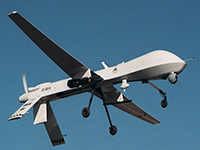There are quite a few relevant international regimes controlling the sale and use of drones. The MTCR (Missile Technology Control Regime), originally set up to regulate the proliferation of Weapons of Mass Destruction missile delivery systems, is widely considered the main instrument for limiting the proliferation of UAVs (unmanned aerial vehicles). In 2017, the MTCR turned 30 and calls are being made for the MTCR to focus solely on “traditional” rockets, missiles and cruise missiles because in its current formulation it too strongly curbs the sale of UAVs.
In PRIF Report No. 149 "Preserve Past Achievements! Why Drones Should Stay within the Missile Technology Control Regime (for the Time Being)", Niklas Schörnig warns against hollowing out the MTCR without replacing it with a new and broader regime and recommends safeguarding the arms-control norms embedded within the MTCR.
